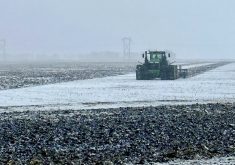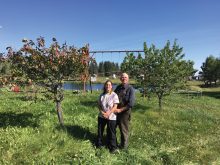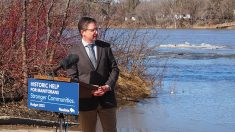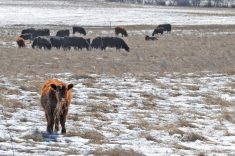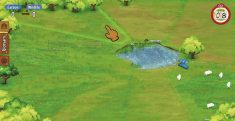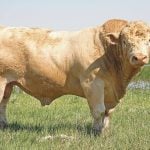An effort to track the environmental impact of various management practices in the ‘real world’ of agricultural Manitoba is bearing its first fruit.
Living Labs – Eastern Prairies is an effort spearheaded by Agriculture and Agri-Food Canada over four watersheds in the province: Upper Oak River, Swan Lake, North Shannon Creek and Main Drain.
The Seine Rat Rosseau Watershed District (SRRWD), which encompasses the Main Drain watershed, recently held a tour to highlight some of the research underway through the program.
Read Also

Land agreement inked for Cereals Canada GATE facility
James Richardson & Sons, Limited will provide land for the Global Agriculture Technology Exchange (GATE) building in Winnipeg, according to memorandum of understanding with Cereals Canada
Dorthea Gregoire, regenerative agriculture co-ordinator with SRRWD, led the tour, noting the group was excited to watch projects take form since their launch in 2019.
“Everything that we started off in Living Labs seemed really unattainable four years ago, so it’s nice to see everything flowing together,” she said.

At the heart of the effort is collaboration with local farmers to monitor and upgrade land use practices.
The first site on the tour was a project to monitor water flow and quality from tile drainage on a 45-acre heavy clay soil site at Les Felsch’s farm.
“It is an ideal site for monitoring because it’s buffered by the road and there’s no overland flow from other fields,” said Steve Sager of AAFC Morden.
All water running off the site accumulates in a manhole equipped with sensors that allow researchers to monitor flow, sediments, nutrient levels and salinity as water emerges from the tile. A weather station automatically uploads information that is accessible at any time. The station can also be programmed to send a text message to researchers when a specific event occurs.
This site is paired with three other drainage projects; two in North Shannon Creek and one in Swan Lake.
“So these four sites will provide data to get a better understanding of the impact of tile drainage and to come up with BMPs (best management practices) to address any concerns,” Sager said.

The goal is to examine what soil and landscape factors impact yield and have data that allows farmers to tweak their practices for next season.
Gregoire said there’s no agenda attached to the information provided to the farmer.
“Often when you’re talking about tile drainage, the first point of contact is the salesman,” she said. “So from our point of view, it’s always really nice to be able to put our producers in contact with people who have experience and knowledge but don’t have any sales objectives.”
Neil Claringbould’s farm was the next stop on the tour, where SRRWD helped him set up a retention pond with a simple and inexpensive design. A berm was placed across the creek channel. A culvert allows low flow to pass unhindered and the large rock-reinforced spillway accommodates high flow.
The retention pond is one of two on Claringbould’s farm, and there’s a third one along the same creek on Wayne Chabaty’s property.
“Now we’re starting to put them in series,” said Joey Pankiw, interim manager with SRRWD. “We’re just slowing the water down to help alleviate some of the pressure on municipal infrastructure as we go down the drain.”
“Altogether, 10 producers have done water retention with us,” Gregoire said. They participated in a survey conducted by the International Institute for Sustainable Development, which did a cost-benefit analysis of the practice.

“Although they’re still finalizing their draft, they’re talking about a three-to-one cost benefit,” Gregoire said. “So for every dollar we’re putting into these retentions, whether it’s the producers or the municipality, they’re gaining $3.”
Gregoire said the 3:1 ratio is conservative because the benefits are hard to quantify.
The final stop on the tour was a Claringbould hay field. Mae Elsinger from AAFC Brandon is gathering data to help with grazing management.
“We’re starting to see a lot more funding coming forward for grazing management practices that help to sequester carbon into carbon dioxide,” Elsinger said. “Grazing pastures aren’t all the same; they all have different levels of productivity, whether it’s because of soil type or what was planted there and the health of it.”
Her job is to examine forage productivity and pasture health on different soils, vegetation types and grazing practices. To do so, she has set up three grazing cages to protect certain areas from cattle. She took a cut at peak productivity in early July and came back in mid-September to get a regrowth sample.

Elsinger divides the material into grassy and leguminous material, takes it to the lab, dries it and weighs it.
“That will give us forage productivity and the ratio of legume to grass,” Elsinger said. After that, she grinds the material and sends it to a feed quality lab in Winnipeg to determine crude protein, mineral content and digestibility.
“This will be one of our better productivity fields. We’re fortunate this year to have rainfall to give us great regrowth.”




